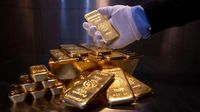Gold reached an unprecedented milestone on Tuesday, April 22, 2025, as the price for a fine ounce (approximately 31.1 grams) soared to $3500 for the first time in history. This marks a significant increase of over two percent from the previous evening, following a near three percent rise the day before. The surge is largely attributed to the erratic economic policies of U.S. President Donald Trump, who has been vocally critical of the U.S. Federal Reserve's Chairman, Jerome Powell.
Trump, 78, recently labeled Powell, 72, as a "major loser" and "Mr. Too Late," criticizing the Fed for not lowering interest rates. Despite Trump's claims that inflation is virtually non-existent in the U.S., consumer prices rose by 2.4 percent in March compared to the same month last year. This inflationary pressure, coupled with fears of a potential recession due to ongoing trade conflicts, has led investors to flock to gold as a safe haven.
Since the end of March, the price of gold has climbed nearly twelve percent, and the overall increase for the year stands at about one third. This follows a substantial 27 percent rise in 2024. Gold has consistently been viewed as a stable investment during times of uncertainty, making it particularly appealing in the current economic climate.
The recent volatility in the stock markets can also be traced back to Trump's confrontational stance towards Powell. Following Trump's comments on Easter Monday, April 21, the New York stock exchanges experienced significant losses, with the Dow Jones Industrial Average dropping 2.5 percent and the Nasdaq 100 falling by the same percentage. The S&P 500 also saw a decline of 2.4 percent.
Analysts are warning that Trump's aggressive trade policies could lead to slower economic growth or even a recession in the U.S. This sentiment is echoed by many economists who fear that the ongoing trade war could have dire consequences for the global economy. Market participants are particularly sensitive to any hints of instability from the White House, which adds to the overall market nervousness.
In the wake of these developments, the U.S. dollar has weakened, losing about six percent of its value against the euro since early April. This depreciation of the dollar makes gold, which is priced in dollars, more expensive for investors using other currencies, further driving up demand.
Gold's performance has outpaced many traditional investments in recent years. The average annual return of gold has been around 15 percent since 2020, significantly outperforming most government bonds. However, when compared to stocks, gold's performance has been mixed. While it has done well against certain indices, many individual stocks, particularly in the tech sector, have seen even greater gains. For instance, companies like Nvidia and Tesla have experienced substantial increases in their stock prices, overshadowing gold's recent rally.
The current market conditions suggest that as long as the U.S. dollar remains weak and fears of a recession linger, investors will continue to purchase gold. In the short term, analysts predict that the gold price is likely to keep rising, bolstered by ongoing economic uncertainty.
However, the gold rally could end abruptly if the U.S. government were to reverse its trade policies, particularly if tariffs on China were lifted. Such a move could stabilize the dollar, prompting investors to cash in their gold profits and reinvest in dollar-denominated assets.
For individual investors, particularly those with long-term savings or retirement funds, it might be prudent to disregard the current rising gold prices. The volatility of the market, influenced by unpredictable political decisions, poses risks for those who cannot monitor their investments closely.
In summary, the gold market is responding to a complex interplay of economic factors, including inflation concerns, trade policies, and political instability. As investors navigate this turbulent landscape, gold continues to shine as a preferred asset amidst uncertainty.









